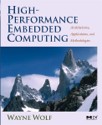Book explains high-performance embedded computing
Aug 25, 2006 — by LinuxDevices Staff — from the LinuxDevices Archive — views Elsevier has published a new book on performance-oriented embedded computing. High-Performance Embedded Computing — Architectures, Applications, and Methodologies, by Wayne Wolf of Princeton University, covers advanced topics in embedded computing, including multiprocessors, VLIW and superscalar… architectures, and power consumption, according to the publisher.
Elsevier has published a new book on performance-oriented embedded computing. High-Performance Embedded Computing — Architectures, Applications, and Methodologies, by Wayne Wolf of Princeton University, covers advanced topics in embedded computing, including multiprocessors, VLIW and superscalar… architectures, and power consumption, according to the publisher.
(Click here for larger image of cover)
The publisher claims that this is the “first book designed to address the needs of advanced students and industry professionals.” The book is described as taking a “uniquely quantitative approach” to the design of embedded systems, describing the design challenge in terms of achieving quantifiable goals for performance, power and energy consumption, and cost. The book explores the three key aspects of design — architectures, algorithms (analysis, simulation, and synthesis tools), and methodologies — to reveal how their inter-relationships impact design decisions and project goals, according Elsevier.
The book's seven chapters cover:
- Embedded Computing
- CPUs
- Programs
- Processes and Operating Systems
- Multiprocessor Architectures
- Multiprocessor Software
- Hardware/Software Co-Design
Wayne Wolf is a professor of electrical engineering at Princeton University.
High Performance Embedded Computing is scheduled to be released September 8, according to the publisher. More details are available at the publisher's website, here.
This article was originally published on LinuxDevices.com and has been donated to the open source community by QuinStreet Inc. Please visit LinuxToday.com for up-to-date news and articles about Linux and open source.